Chapter 7 - Transport in Flowering Plants
Transport vessels
%%Vascular tissues%% of the plant consist of xylem vessels and the phloem.
%%Xylem vessels%% are elongated hollow tubes that are made of xylem cells linked end to end. Xylem cells are dead at maturity.
Functions of xylem tissue:
- %%Conduct water and mineral salts%% from the roots to the leaves
- %%Mechanical support%%
Adaptations to these functions include:
- %%Absence of protoplasm and cross-walls%% which could impede water flow through the lumen (central space)
- %%Deposition of lignin%% on the cell walls which strengthens vessel walls, providing support
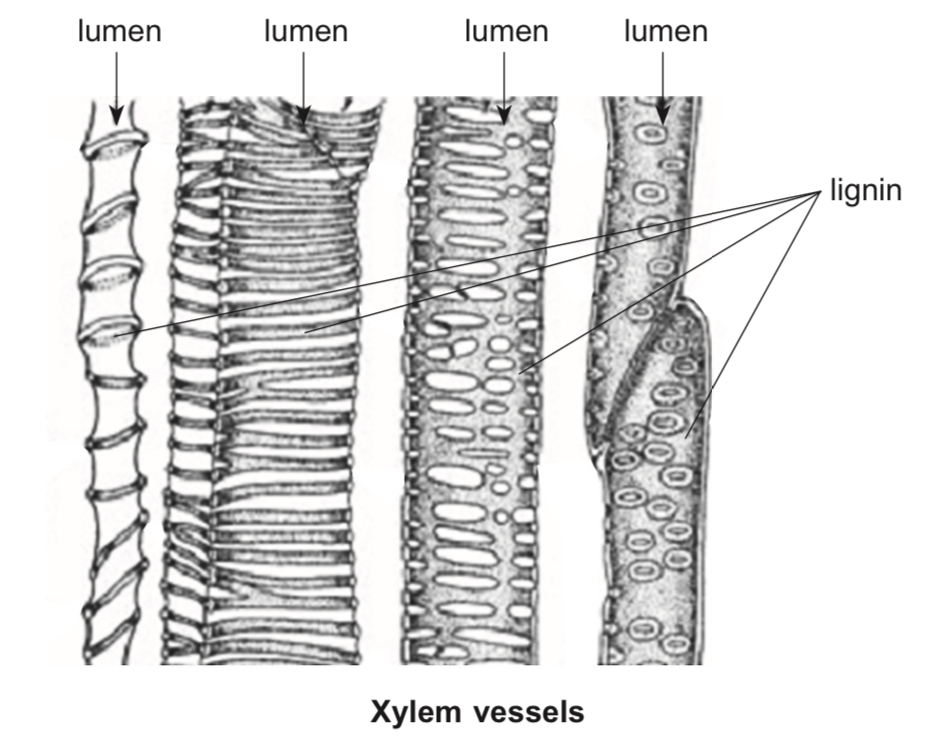
The %%phloem tissue%% consists of sieve tube elements and companion cells.
%%Sieve tube%% elements are elongated thin-walled living cells. They have %%degenerate protoplasm%%, which means they %%lack organelles%% such as the nucleus, ribosomes and the large central vacuole.
Sieve tube elements are arranged end to end, with %%porous walls%% called sieve plates between them.
There is one %%companion cell%% closely associated with each sieve tube element. Companion cells contain nuclei, cytoplasm and numerous mitochondria, and are responsible for performing the metabolic functions of the sieve tube elements.
The function of the phloem is to %%conduct sugars and amino acids%% from the leaves to other parts of the plant.
Adaptations to this function include:
- Porous sieve plates that allow %%uninterrupted flow%% of food substances through the sieve tubes
- %%Numerous mitochondria%% in the companion cells that provide energy for them to help load sieve tube members with sugar
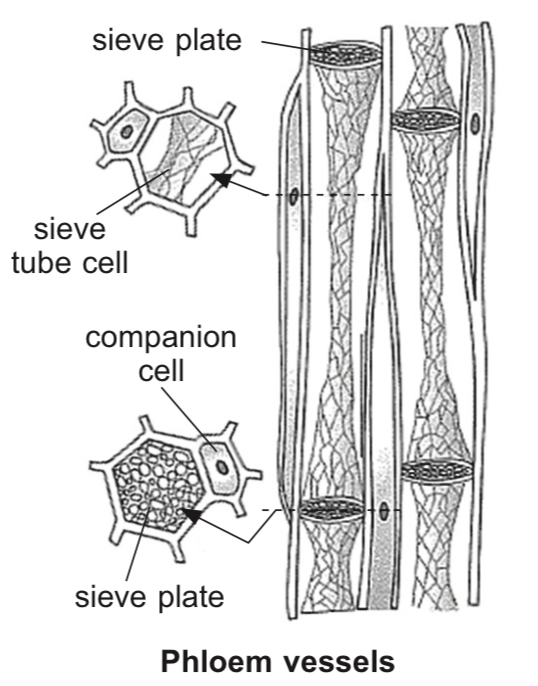
Position of vascular tissue in dicotyledonous stems
In %%dicotyledonous stems,%% the %%vascular bundles%% are arranged in a ring around a central pith.
Between the ring of vascular tissue and the epidermis is the cortex. The epidermis is covered by %%waterproof cuticle%% that minimises water loss in the stem.
Within the vascular bundles, the phloem tissue is found on the side facing the cortex and the xylem on the side facing the pith. Between the xylem and phloem is a layer called the cambium. %%Cambium cells%% can differentiate into new xylem and phloem tissues.
Food is stored in the %%cortex%% and %%pith%%.
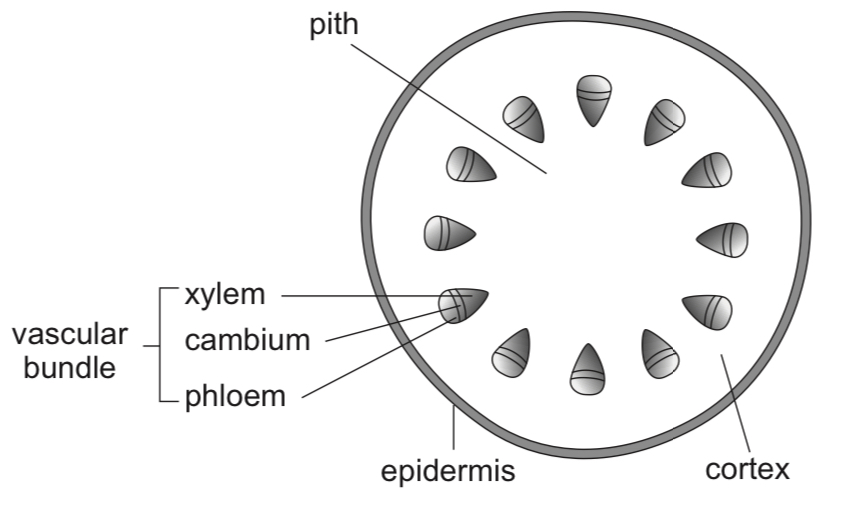
Position of vascular tissue in dicotyledonous roots
The outermost layer of the root is the %%piliferous layer%%. It is a single layer of cells bearing %%root hairs%%.
The layer below the epidermis is called the cortex. It consists of storage tissue.
The central region of the root contains xylem and phloem tissues. The xylem radiates from the centre, with phloem tissues alternating between them.
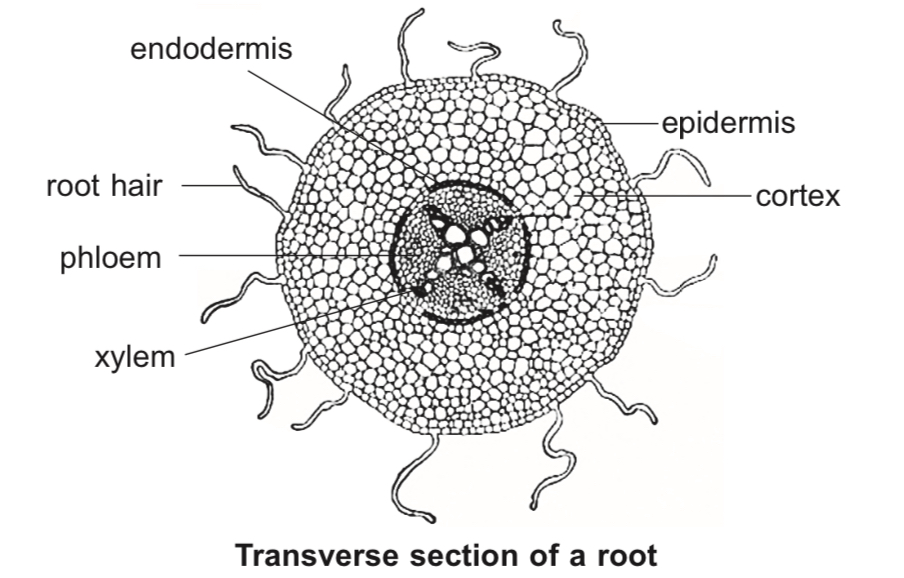
Root Hair Cells
Root hairs are %%tubular outgrowths of root epidermal cells%%. Each root hair is usually an outgrowth of a single epidermal cell, so they are %%one-cell thick.%%
Being long and narrow, they have a %%large surface area to volume ratio%% for %%rapid absorption%% of water and minerals.
The cell surface membrane controls the water potential of the cell sap. The cell sap has a lower water potential than the %%soil solution%%, causing %%osmosis%% to take place.
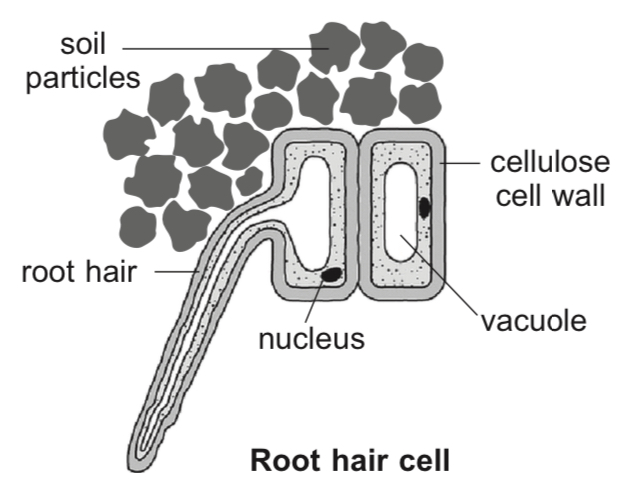
Absorption of water and minerals by root hair cells
Soil particles are usually coated with water and dissolved mineral salts.
The %%cell sap%% in the root hair cells contains sugars and ions that cause it to be at a lower water potential than soil solution.
Water moves across the %%partially permeable cell surface membrane%% from the soil solution into the cell sap by %%osmosis%%.
The cell sap now has a higher water potential than the cell sap in the adjoining cell.
Water moves across the cell surface membranes into the adjoining cell by osmosis.
This process continues until the water enters the xylem vessels and moves up the plant.
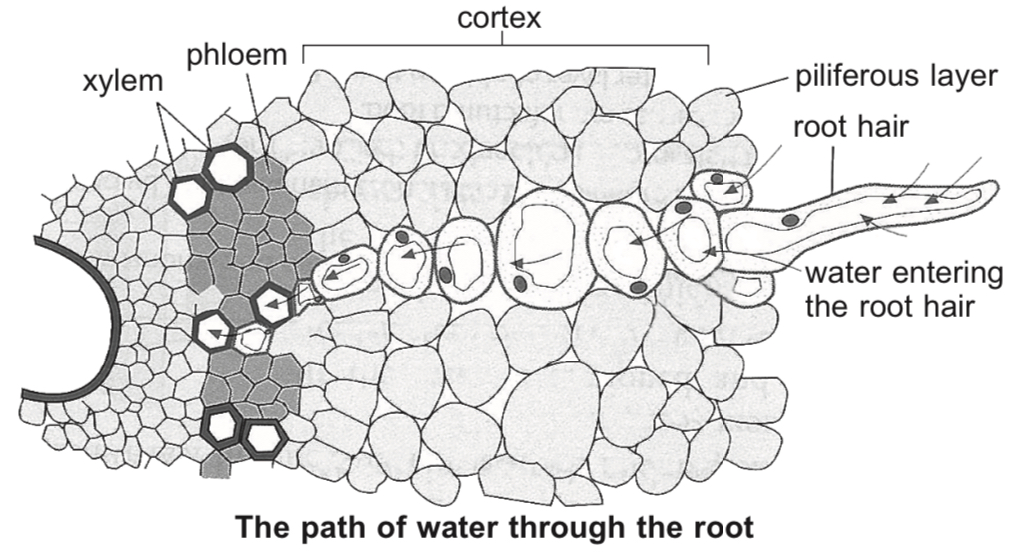
Transportation of water from the roots to the leaves
- Water travels from the roots to the leaves against gravity through 3 primary mechanisms:
- %%Root pressure%%
- %%Transpiration%%
- %%Capillary action%%
- Root cells pump mineral salts into the xylem vessels using active transport. This causes the water potential of the xylem vessels to be lower than the water potential in the cortex cells. Water moves into the xylem vessels by osmosis, creating a pressure that forces water to move upwards. This is called %%root pressure%%.
- Root pressure is not the main mechanism for movement of water in most plants as it can only force water to travel a short distance.
- %%Transpiration%% is the loss of water vapour from the %%stomata%% of the leaves through %%diffusion%%.
- The stomata have to be open for carbon dioxide intake due to %%photosynthesis%%. This allows the loss of water vapour from the %%intercellular air spaces%% in the leaves as the air outside has a lower water vapour concentration than the air inside the leaf. Transpiration is the necessary cost of carbon dioxide intake.
- However it is also responsible for the %%transpiration pull%%, which is the main force that causes water to travel upwards in plants.
- Transpiration pull is the suction force caused by transpiration that pulls water up the xylem.
- %%Capillary action%% is the tendency of water to travel up the narrow xylem tubes due to the interactions between water molecules and the xylem walls. This is usually observed in young plants with narrow veins and is not significant in larger plants.
Factors affecting the rate of transpiration
Water vapour in the intercellular air space diffuses out of the stomata.
%%Evaporation from the thin film of water%% that coats the %%mesophyll cells%% replaces the water lost through transpiration.
As water evaporates from the mesophyll cells, the water potential of the %%cell sap%% decreases. The mesophyll cells absorb water from neighbouring cells closer to the %%vascular bundles%% by osmosis. These cells, in turn, absorb water from the xylem vessels.
This creates a suction force that pulls the entire column of water up the xylem vessels.
Factors affecting transpiration are:
- %%Humidity of the surroundings%% – Humidity affects the concentration gradient of water vapour between the intercellular air spaces in the leaf and the external environment. The higher the humidity, the higher the concentration of water vapour in the external air. The diffusion gradient for water vapour is less steep so the rate of transpiration is lowered.
- %%Air movement%% – Wind removes the water vapour that accumulates outside the stomata due to transpiration. This maintains the steep diffusion gradient of water vapour. The rate of transpiration will remain high as long as water vapour is continually being removed by wind.
- %%Temperature%% – Heat increases the rate of evaporation and also increases the movement of water molecules. The higher the temperature, the higher the rate of evaporation as well as the rate of movement of water vapour, and thus, the higher the rate of transpiration.
- %%Light intensity%% - Light intensity causes stomatal opening. Since transpiration takes place mainly through the stomata, the rate of transpiration will increase with increased light intensity.
%%Wilting%% takes place when the rate of transpiration exceeds the rate of water intake by the roots. Plant cells lose water and become %%flaccid%%.
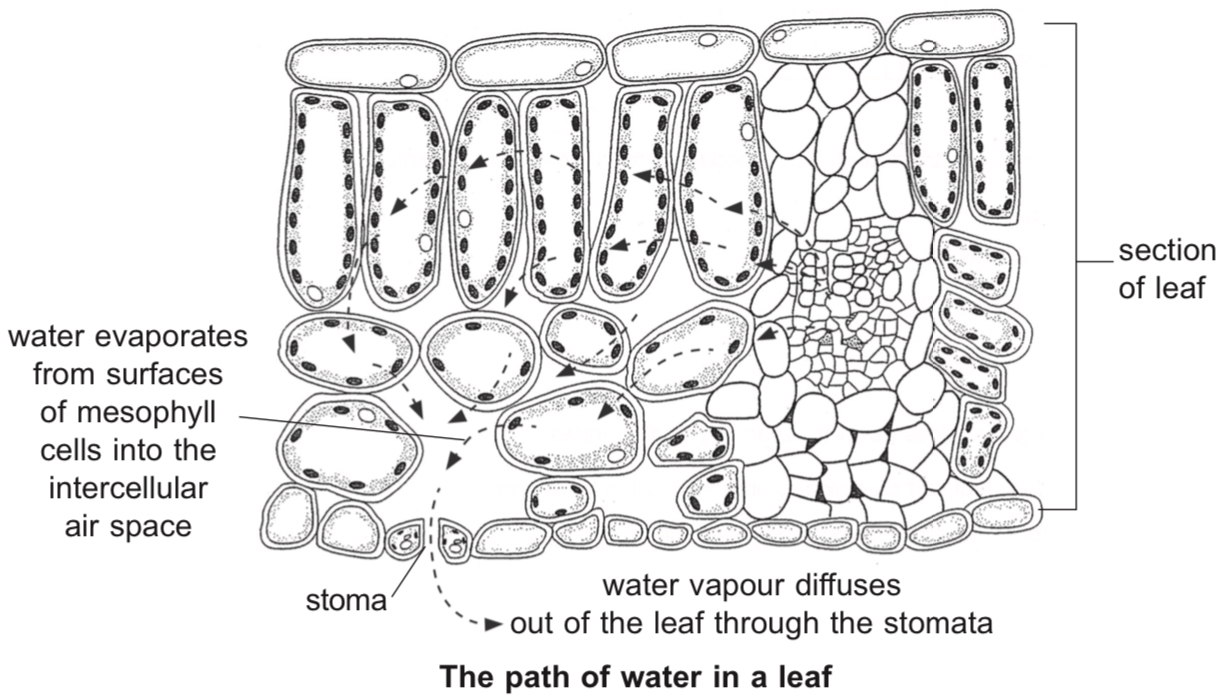
Translocation
- %%Translocation%% is the transport of sugars from the leaves to other parts of the plant. This is done by the %%phloem tissues%%. The leaves, which supply sugar, are known as the source while other parts of the plant which require sugar are known as the sink.
- Energy is required for this process as the mode of uptake of sugars into sieve tube elements in the leaves is %%active transport.%%
- At the end of the sieve tube where sugars are being unloaded for use, sugars are also removed from the %%sieve tube%% by active transport.